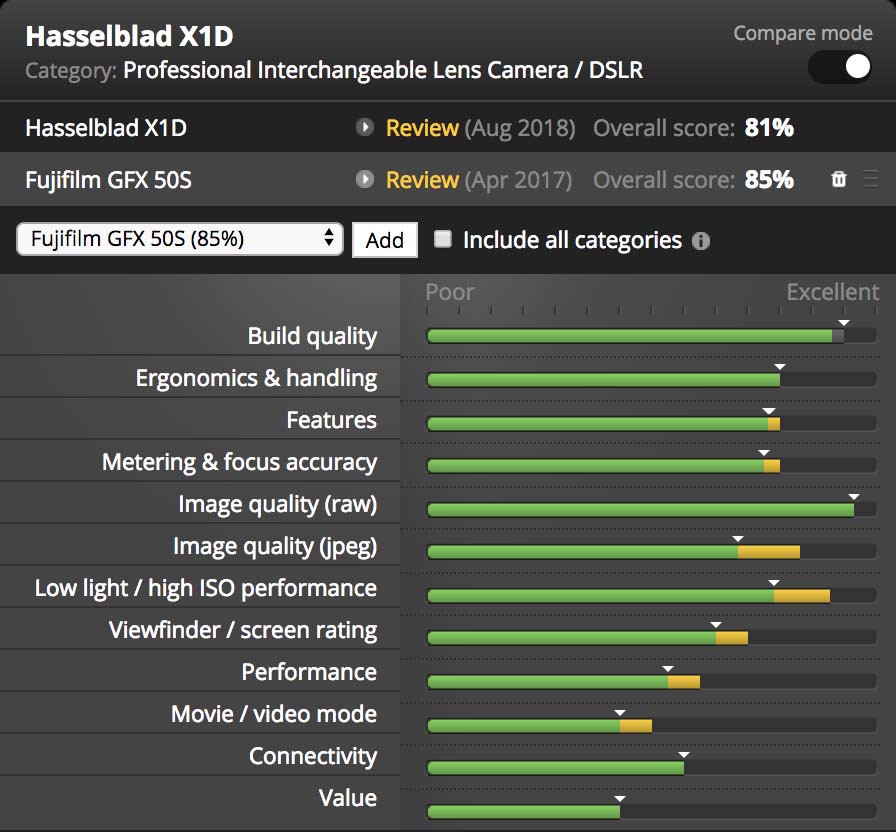
DPReview published their Fujifilm GFX50S review around 1 year ago, but they gave Hasselblad some time to improve their camera before completing their Hasselblad X1D review. Over the past year, Hasselblad has improved the X1D in a variety of ways that have made it a competitive camera, but it is still far from perfect and not quite up to competing with the Fujifilm GFX50S. Below is a summary of DPR’s Reviews and if you want to read their X1D review you can do so here or the GFX50S review here.
| Fujifilm GFX 50S |
Hasselblad X1D |
Pros
- 51.4MP, 44 x 33mm sensor yields high image resolution
- Excellent image quality in both Raw and JPEG
- ISO invariant behavior used above ISO 1600 to give increasing amounts of highlight recoverability
- Contrast Detect AF is accurate and precise
- Fujifilm color science, and color chrome effect, in larger than APS-C size
- Direct controls provide for engaging shooting experience
- AF joystick + touchscreen makes selecting an AF point simple, effective
- Touchscreen flips vertically and horizontally
- Weather-sealing and solid build quality
- Comfortable ergonomics
- Plenty of custom buttons
- Dual card slots give flexibility and capacity
- Electronic first curtain shutter mode minimizes risk of shutter shock
- Lack of mirror avoids mirror-induced shock other MF systems bring
- In-camera Raw processing lets you make full use of excellent JPEG engine
- Easy-to-use Wi-Fi
Cons
- Slow native lenses do not take full advantage of camera’s sensor size
- Contrast Detect AF speeds can be sluggish in moderate light, often fails in dim or backlit situations
- Relatively low flash sync speed
- AF-C is virtually unusable due to constant hunting
- Moiré is visible in fine detail and patterns
- ‘Shimmering’ and moiré in the EVF when focus is initiated
- Significant rolling shutter in complete (silent) E-shutter mode
- No way to link minimum shutter speed to focal length with Auto ISO
- Significant color shift at highest ISOs
- No ISO 100 during video capture
- No dedicated exp. comp. dial
- Rear dial can be difficult to turn due to its position
- Limited lens selection at launch
|
Pros
- Excellent resolution
- Extensive dynamic range
- Intelligently implemented high ISO modes
- Precise, accurate autofocus
- Simple, to-the-point control system
- Touchpad AF works well
- Impressive solidity of build
- Leaf shutter minimizes size and almost eliminates risk of shutter shock
- USB 3.0 tethering option
- Novel, customizable user interface
- Nikon-compatible TTL flash system
Cons
- Slow autofocus
- Limited battery life
- Somewhat laggy experience
- No wide-aperture lenses available
- Leaf shutters add to lens cost
- Occasional but significant risk of moiré
- Camera’s low-res JPEGs don’t give 100% coverage
- Significant rolling shutter in complete (silent) E-shutter mode
- Simplistic Auto ISO implementation
|
Join our Fujifilm GFX Owners Group, also follow the Fujifilm GFX Page to get more tailored news on Facebook and follow Fujiaddict on Facebook and Twitter.
Fujifilm GFX 50S: B&H Photo / Amazon / Adorama
Hasselblad X1D-50c: B&H Photo / Amazon / Adorama
This entry was posted in Fujifilm GFX, Fujifilm GFX 50S and tagged Fuji GFX, Fuji GFX 50R, Fuji GFX50R, Fuji Rumors, Fujifilm, Fujifilm GFX 50R Medium Format, Fujifilm GFX50R, Fujifilm Rumors, FujifilmRumors, Fujirumors, GFX, GFX 50R, GFX50R, Hasselblad X1D, Hasselblad X1D-50c, Super Full Frame. Bookmark the
permalink. Trackbacks are closed, but you can .

